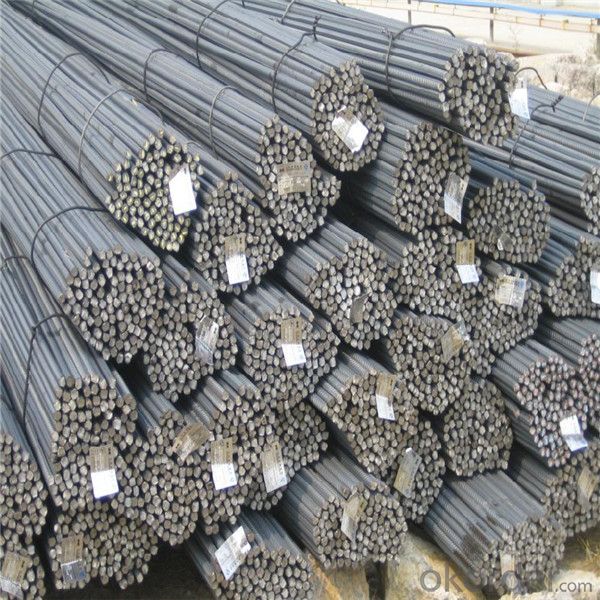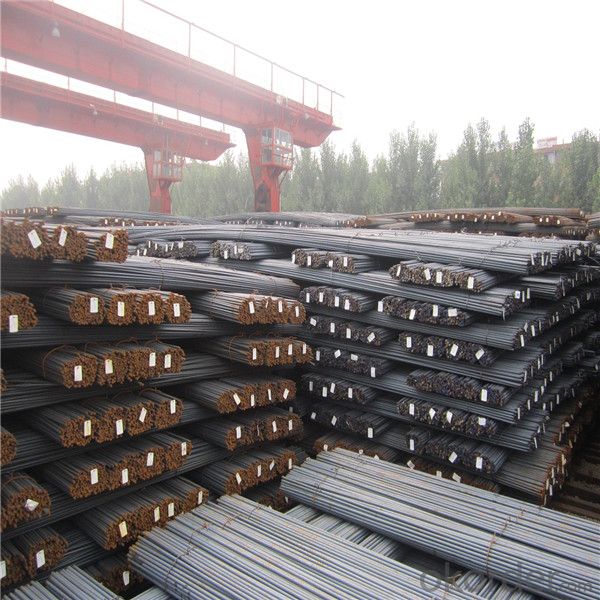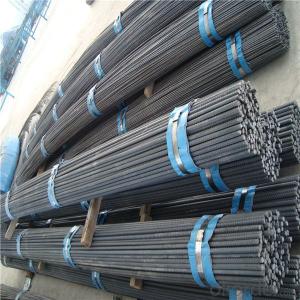Steel rebar 12mm 16mm for real estate constraction
- Loading Port:
- Tianjin
- Payment Terms:
- TT OR LC
- Min Order Qty:
- 100 m.t.
- Supply Capability:
- 18000 m.t./month
OKorder Service Pledge
OKorder Financial Service
You Might Also Like
Specification
Steel rebar is bars of steel commonly used in construction, especially for reinforcing concrete structures such as
driveways, foundations, walls, and columns. These bars come in different sizes and strength grades, and can be
smooth or may include deformations that provide greater adhesion for concrete poured over the bars. When used
in poured concrete, the bars are typically placed in a grid pattern, the concrete poured over them, and then readjusted
to maintain the proper shape while the concrete sets. Steel rebar can be purchased from a number of manufacturers
and is often found at construction retailers or large hardware stores.
Our Advantage: High quality steel products from 1 class mills in China
Reasonable price
Professionalism of the products
On-time delivery
Complete documents and certificates
Sincere service to meet our clients' requirements
Product Description :
Chemical composition (%): | Steel | C | Si | Mn | P | S | Ceq | ||||
HRB335 |
0.25 |
0.80 |
1.60 |
0.045 |
0.045 | 0.52 | |||||
HRB400 | 0.54 | ||||||||||
HRB500 | 0.55 | ||||||||||
Mechanical properties | Steel | Rel/ MPa | Rm/ MPa | A/ % | Agt/ % | ||||||
≥ | |||||||||||
HRB335 | 335 | 455 | 17 |
7.5 | |||||||
HRB400 | 400 | 540 | 16 | ||||||||
HRB500 | 500 | 630 | 15 | ||||||||
Package: | Standard export packing or as customer's request | ||||||||||
Application: | Construction, building, bridge, road. ect | ||||||||||
Payment terms | 1).100% irrevocable L/C at sight. | ||||||||||
Delivery time | 15-30 days after receipt of L/C or deposit by T/T | ||||||||||


Packing:
In bundles, each bundle weight 3.5 tons. Load by container or by bulk verssel.


Our service
(1) We cooperate with famous factories with advanced equipment and well trained workers.
(2) We can provide factory price with trading company service.
(3) We continuously work on the improvement of our processes, guaranteeing consistently high standards
of quality to keep none compensation.
(4) We guarantee 24 hours response and 48 hours solution providing service.
(5) We accept small order quantity before formal cooperation.
(6) We deliver the agreed quality at the agreed time, reacting to changes in customer wishes in a flexible way.
(7) Due to our volume and selling power, we have excellent freight rates with shipping lines.
(8) We strive to always be fair and honest in our dealings with customers.
(9) We strive to work together with customers to achieve much more than we can achieve alone.
(10) Through our passion and commitment we aim to be a market leader in all our key markets. To maintain
our position as market leader we must continue to add value in all that we do.
FAQ:
1.Q: What's your MOQ(minimum order quantity)?
A: One full container, mixed acceptable .
2. Q: What's your packing methods?
A: Packed in bundle or bulk ..
3. Q: How can I buy CNBM products in my country?
A:Please send us an inquiry or email ,we will reply to you if there is distributor in your country
4. Q: Can we visit your factory?
A: Warmly welcome. Once we have your schedule, we will arrange the professional sales team to follow up your case.
5. Q: How long does it take to get the product if i place an order?
A:With the process of your requirements,we will pack and deliver in 3-7 days. If it is by sea shipment,it will take 15-45 days depending on different locations
- Q: How do steel rebars affect the overall construction schedule?
- Steel rebars can have both positive and negative impacts on the overall construction schedule. On the positive side, rebars, being strong and durable, can enhance the structural integrity of the building, making it safer and more resilient. They also help in speeding up the construction process by providing strength and support to the concrete, allowing for faster curing times. However, the availability and delivery of rebars can sometimes cause delays if there are supply chain issues or if the required quantity is not readily available. Additionally, the installation of rebars requires precision and coordination with other construction activities, which can also impact the timeline. Therefore, while steel rebars can contribute to a more efficient construction schedule, they can also pose challenges and potential delays if not managed properly.
- Q: How do steel rebars affect the durability of concrete in freeze-thaw cycles?
- The durability of concrete in freeze-thaw cycles can be greatly enhanced by steel rebars. When exposed to freezing and thawing conditions, concrete undergoes expansion and contraction. During freezing, the water inside the concrete pores freezes and expands, exerting pressure on the surrounding concrete matrix. This can lead to cracks and deterioration of the concrete. However, the inclusion of steel rebars in the concrete can help alleviate these problems. Steel has a lower coefficient of thermal expansion compared to concrete, meaning it expands and contracts less with temperature changes. This property allows the steel rebars to absorb the stresses generated during freeze-thaw cycles, preventing significant damage to the concrete structure. Furthermore, steel rebars also reinforce the concrete, increasing its overall strength and toughness. This reinforcement helps distribute the stresses caused by freeze-thaw cycles more evenly throughout the concrete, reducing the likelihood of crack formation or propagation. Moreover, steel rebars act as a barrier against water penetration into the concrete. Moisture is a major contributor to freeze-thaw damage. The steel rebars assist in creating a more impermeable concrete structure by reducing the size and number of cracks, preventing water from entering and causing further deterioration. To sum up, steel rebars play a vital role in enhancing the durability of concrete in freeze-thaw cycles. Their ability to absorb stresses, reinforce the concrete, and prevent water penetration significantly reduces the potential for damage and extends the lifespan of the concrete structure.
- Q: Can steel rebars be bent or shaped?
- Yes, steel rebars can be bent or shaped using various methods such as heat, mechanical force, or cold bending techniques.
- Q: Can steel rebars be used in coastal areas?
- Yes, steel rebars can be used in coastal areas. However, it is important to note that the rebars need to be properly coated or protected against corrosion due to the higher levels of salt and moisture in coastal environments.
- Q: Can steel rebars be used in marine or coastal construction projects?
- Yes, steel rebars can be used in marine or coastal construction projects. However, it is important to use corrosion-resistant steel rebars, such as epoxy-coated or stainless steel rebars, to prevent rust and deterioration caused by the harsh saltwater environment.
- Q: Can steel rebars be spliced or joined together on-site?
- Yes, steel rebars can be spliced or joined together on-site. This is typically done using various methods such as welding, mechanical couplers, or lap splicing techniques, depending on the specific requirements and structural design.
- Q: What are the different types of steel rebars used in airport construction?
- There are generally two types of steel rebars commonly used in airport construction: epoxy-coated rebars and stainless steel rebars. Epoxy-coated rebars are corrosion-resistant and provide protection against chemicals often found in airports, such as de-icing agents. Stainless steel rebars, on the other hand, offer superior resistance to corrosion and are often used in areas with high humidity or exposure to saltwater. Both types of rebars are essential in ensuring the structural integrity and longevity of airport infrastructure.
- Q: Can steel rebars be recycled after the demolition of a structure?
- Yes, steel rebars can be recycled after the demolition of a structure. Steel is a highly recyclable material and rebars are commonly collected and reused in the steel industry for the production of new steel products. Recycling steel rebars helps conserve natural resources and reduces the environmental impact of construction projects.
- Q: Can steel rebars be used in the construction of museums and art galleries?
- Yes, steel rebars can be used in the construction of museums and art galleries. Steel rebars provide structural support and reinforcement, making them suitable for ensuring the stability and durability of the buildings. Additionally, steel rebars can be designed and installed in a way that minimizes their visual impact, preserving the aesthetic appeal of the museums and art galleries.
- Q: What is the role of steel rebars in column construction?
- The role of steel rebars in column construction is to provide reinforcement and enhance the structural strength and stability of the columns. Rebars ensure that the column can withstand the applied loads, such as the weight of the structure and other external forces, without experiencing excessive deformation or failure. By distributing and transferring the load, rebars help prevent cracks and improve the overall durability and longevity of the column.
Send your message to us
Steel rebar 12mm 16mm for real estate constraction
- Loading Port:
- Tianjin
- Payment Terms:
- TT OR LC
- Min Order Qty:
- 100 m.t.
- Supply Capability:
- 18000 m.t./month
OKorder Service Pledge
OKorder Financial Service
Similar products
Hot products
Hot Searches
Related keywords


























